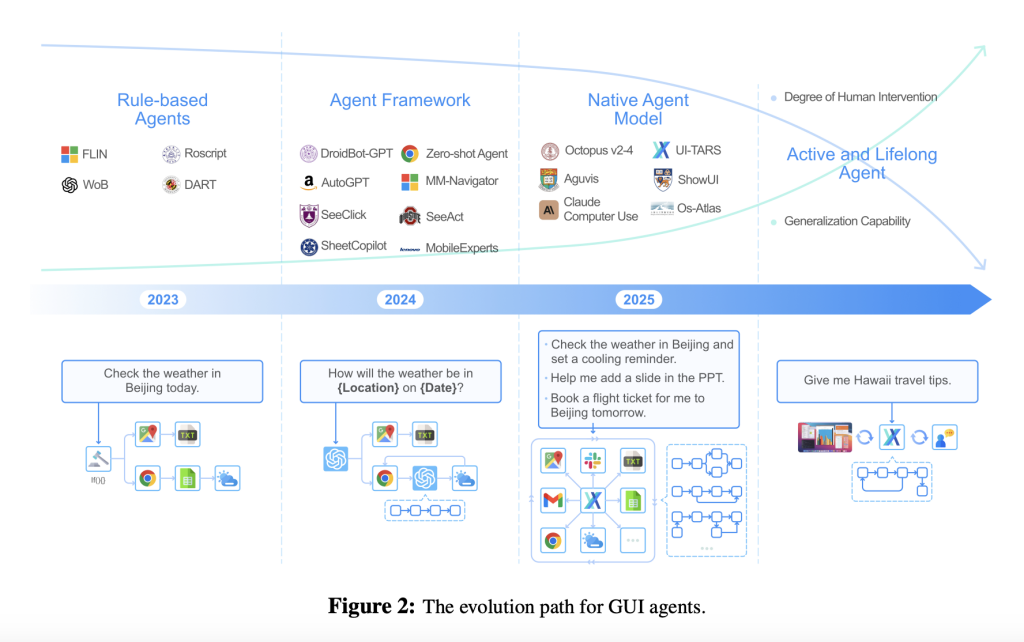

GUI agents seek to perform real tasks in digital environments by understanding and interacting with graphical interfaces such as buttons and text boxes. The biggest open challenges lie in enabling agents to process complex, evolving interfaces, plan effective actions, and execute precision tasks that include finding clickable areas or filling text boxes. These agents also need memory systems to recall past actions and adapt to new scenarios. One significant problem facing modern, unified end-to-end models is the absence of integrated perception, reasoning, and action within seamless workflows with high-quality data encompassing this breadth of vision. Lacking such data, these systems can hardly adapt to a diversity of dynamic environments and scale.

Current approaches to GUI agents are mostly rule-based and heavily dependent on predefined rules, frameworks, and human involvement, which are not flexible or scalable. Rule-based agents, like Robotic Process Automation (RPA), operate in structured environments using human-defined heuristics and require direct access to systems, making them unsuitable for dynamic or restricted interfaces. Framework-based agents use foundation models like GPT-4 for multi-step reasoning but still depend on manual workflows, prompts, and external scripts. These methods are fragile, need constant updates for evolving tasks, and lack seamless integration of learning from real-world interactions. The models of native agents try to bring together perception, reasoning, memory, and action under one roof by reducing human engineering through end-to-end learning. Still, these models rely on curated data and training guidance, thus limiting their adaptability. The approaches do not allow the agents to learn autonomously, adapt efficiently, or handle unpredictable scenarios without manual intervention.

To address the challenges faced in GUI agent development, the researchers from ByteDance Seed and Tsinghua University, proposed the UI-TARS framework to boost native GUI agent models. It integrates enhanced perception, unified action modeling, advanced reasoning, and iterative training, which helps reduce human intervention with improved generalization. It enables detailed understanding with precise captioning of interface elements using a large dataset of GUI screenshots. This introduces a unified action space to standardize platform interactions and utilizes extensive action traces to enhance multi-step execution. The framework also incorporates System-2 reasoning for deliberate decision-making and iteratively refines its capabilities through online interaction traces.

Researchers designed the framework with several key principles. Enhanced perception was used to ensure that GUI elements are recognized accurately by using curated datasets for tasks such as element description and dense captioning. Unified action modeling links the element descriptions with spatial coordinates to achieve precise grounding. System-2 reasoning was integrated to incorporate diverse logical patterns and explicit thought processes, guiding deliberate actions. It utilized iterative training for dynamic data gathering and interaction refinement, identification of error, and adaptation through reflection tuning for robust and scalable learning with less human involvement.

Researchers tested the UI-TARS trained on a corpus of about 50B tokens along various axes, including perception, grounding, and agent capabilities. The model was developed in three variants: UI-TARS-2B, UI-TARS-7B, and UI-TARS-72B, along with extensive experiments validating their advantages. Compared to baselines like GPT-4o and Claude-3.5, UI-TARS performed better in benchmarks measuring perception, such as VisualWebBench and WebSRC. UI-TARS outperformed models like UGround-V1-7B in grounding across multiple datasets, demonstrating robust capabilities in high-complexity scenarios. Regarding agent tasks, UI-TARS excelled in Multimodal Mind2Web and Android Control and environments like OSWorld and AndroidWorld. The results highlighted the importance of system-1 and system-2 reasoning, with system-2 reasoning proving beneficial in diverse, real-world scenarios, although it required multiple candidate outputs for optimal performance. Scaling the model size improved reasoning and decision-making, particularly in online tasks.


In conclusion, the proposed method, UI-TARS, advances GUI automation by integrating enhanced perception, unified action modeling, system-2 reasoning, and iterative training. It achieves state-of-the-art performance, surpassing previous systems like Claude and GPT-4o, and effectively handles complex GUI tasks with minimal human oversight. This work establishes a strong baseline for future research, particularly in active and lifelong learning areas, where agents can autonomously improve through continuous real-world interactions, paving the way for further advancements in GUI automation.
Check out the Paper. All credit for this research goes to the researchers of this project. Also, don’t forget to follow us on Twitter and join our Telegram Channel and LinkedIn Group. Don’t Forget to join our 70k+ ML SubReddit.
The post ByteDance Introduces UI-TARS: A Native GUI Agent Model that Integrates Perception, Action, Reasoning, and Memory into a Scalable and Adaptive Framework appeared first on MarkTechPost.
Source: Read MoreÂ




